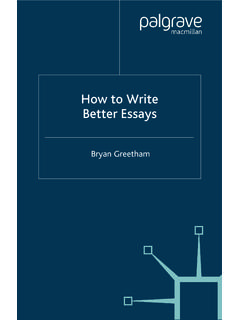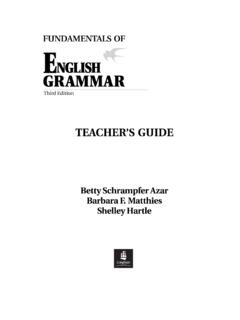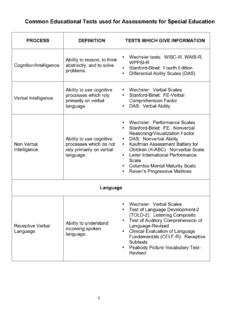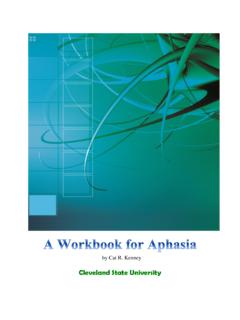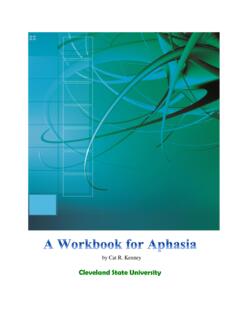Transcription of CHECK YOUR ENGLISH VOCABULARY FOR
1 CHECK your ENGLISH VOCABULARY FORMEDICINE third editionA & C Black published in Great Britain 1995 Second edition published 2000 Third edition published 2006A & C Black Publishers Ltd38 Soho Square, London W1D 3HB Peter Collin Publishing 1995, 2000 A & C Black Publishers Ltd 2006 All rights part of this publication may be reproduced inany form without the permission of the CIP entry for this book is available from the British LibraryISBN-10: 0 7136 7590 XISBN-13: 978 0 7136 7590 0 eISBN-13: 978-1-4081-0238-1 Text typeset by A & C BlackPrinted in Italy by LegoprintA & C Black uses paper produced with elemental chlorine-free pulp,harvested from managed sustainable worksheets in this workbook contain a variety of exercises appropriate for studentsrequiring a working knowledge of ENGLISH medical terminology. The worksheets can be usedeither for self-study or in the classroom and can be completed in any order. Several have'extensions': short classroom exercises based on the language in the main exercise.
2 All thequestions within this workbook are based on the A & C Black Dictionary of Medical Terms,fourth edition (ISBN 0 7136 7603 5).This workbook is aimed at students with at least an intermediate level of ENGLISH . However,many people who work in medicine have to read in ENGLISH on a regular basis; students witha more basic level of ENGLISH may therefore already have the passive VOCABULARY to handlemany of the vocabularyIt is important to appreciate that 'knowing' specialist VOCABULARY involves more than simplyrecognising it. You can understand the meaning of a word when reading or listening and yet beunable to remember that same word when speaking or writing. You may remember the word, but use it incorrectly. This can be a grammaticalproblem, like knowing that 'fracture' can be used both as a noun and as a verb. Orit may be a question of collocation: a surgeon makes an incisionduring an operation,but when he wants a piece of bread he simply cutsit.
3 Then there is the question of the sound of the word. Can you pronounce it? And doyou recognise it when you hear it pronounced?For these reasons - memory, use and sound - it is important that students practise specialistvocabulary so that they can learn to use it more confidently and effectively. The exercises inthis workbook will help students to expand their knowledge and use of medical VOCABULARY . Using the Dictionary of Medical TermsAll of the VOCABULARY taught or practised in this workbook is in the A & C Black Dictionary ofMedical Terms. The Dictionary of Medical Termsgives definitions in simple ENGLISH whichstudents can read and understand. Many of the examples and definitions in the workbookare taken directly from the dictionary. Students should have a copy of the Dictionary ofMedical Termsfor referring to when completing the exercises; using the dictionary is anessential part of successful language of a Dictionary of Medical TermsentryEach entry within the dictionary includes key elements that help a student understand thedefinition of the term and how to use it in context.
4 Each term has a clear example, and partof speech . This is followed by example sentences and quotations from newspapers andmagazines that show how the term is used in real life. These elements of the dictionary areused to create the questions within this Record SheetAt the back of the book is a VOCABULARY Record Sheet. Recording useful VOCABULARY in amethodical way plays a key role in language learning and could be done, for example, at theend of each lesson. The Dictionary of Medical Termsis a useful tool for ensuring that thepersonal VOCABULARY record is accurate and is a good source for example sentences to showhow words are used, as well as for notes about meaning and pronunciation, contentsWORD-BUILDING1 Self-studyWord association 1:missing linksLinking each set of four words with one other word2 Self-studyWord formation:nounsForming nouns from list of verbs; rewriting sentencesusing noun forms instead of verbs3 Self-studyTwo-word expressionsCombining words from two lists to make two-wordexpressions that fit the definitions4 Self-studyPlural formationMultiple choice: choosing correct plural forms of singularnouns5 Self-studyWord formation:adjectivesRewriting sentences using adjective forms instead ofnouns6 Self-studyWord association 2:partnershipsLinking each verb with a noun to make a 'partnership'.
5 Using the 'partnerships' to complete sentences7 Self-studyOpposites 1: prefixes Selecting the correct prefix for each adjective to create anopposite; using the adjectives to complete sentencesExtension: working with a partner to test one another8 Self-studyWord formation: verbsMaking verb forms from list of nouns; writing sentencesusing the verbs9 Self-studyWord association 3: mind mapsFinding words in a mind map that fit definitions;designing mind maps PARTS OF SPEECH10 Self-studyNouns Sentence completion11 Self-studyAdjectives 1 Sentence completion12 Self-studyAdjectives 2 Sentence completion13 Self-studyVerbs 1 matching verbs with their correct definitions14 Self-studyVerbs 2 matching verbs with their correct definitions15 Self-studyVerbs: past tense ~regular verbsSentence completion16 Self-studyVerbs: mixed tensesSentence completion17 Self-studyPhrasal verbsSentence completionExtension: working with a partner to write a dialogueusing phrasal verbs18 Self-studyVerbs: active/passiveChanging sentences from active to passive tense19 Self-studyAdverbsIdentifying adverbs in sentences and swapping adverbsaround so that each sentence makes sense20 Self-studyPrepositionsCorrecting sentences with deliberate mistakes in the prepositionsPRONUNCIATION21 Self-studyPair workWord stress 1 Identifying three-syllable words and classifying by theirpronunciationExtension.
6 Practising the dialogues with a partner22 Self-studyWord stress 2 Completing sentences using four-syllable words;classifying four-syllable words by their pronunciation23 Pair workPresent simpleIdentifying present tense verbs and classifying by theirpronunciationExtension: working with a partner to identify pluralnouns in each pronunciation category24 Self-studyPast tenseIdentifying past tense verbs and classifying by theirpronunciationPageModeTitleDescripti onVOCABULARY IN CONTEXT25 Self-studyPair workGood adviceMatching half-sentences together to make completesentencesExtension: writing pieces of medical advice with apartner26 Self-studyMultiple meaningsClassifying meanings27 Self-studyOdd one outIdentifying word that is different to others in each set28 Self-studyBody parts - categoriesDeciding which category each body part belongs to29 Self-studyPair workOpposites 2 matching words with opposite meanings; insertingcorrect opposites in sentencesExtension: working with a partner to test one another30 Self-studyPair workAbbreviations Stating what abbreviations stand forExtension: working with a partner to test one another31 Self-studySymptoms & commonillnesses 1 Checking meanings of words; matching descriptions tonames of illnesses32 Self-studyPair workSymptoms & commonillnesses 2 matching formal and informal names of illnesses.
7 Completing conversations by using informal names ofillnessesExtension: practising conversations with a partner33 Self-studyPair workDiagnosisIdentifying each disease or illness from its descriptionExtension: writing a description of a disease or illnessand testing a partner34 Self-studyHow it worksMatching half-sentences together to make completesentences35 Self-studyPair workInstruments andequipmentMatching each instrument and item of equipment withits correct description Extension: working with a partner to test one another36 Self-studyPair workChemistryMatching symbols of chemical elements and compoundswith correct names and descriptionsExtension: working with a partner to test one anotherPUZZLES & QUIZZES51 Answer keyAnswers to all worksheets37 Self-studyAnagrams 1 Solving anagrams by reading clues and putting letters in order38 Self-studyParts of the bodycrossword 1 Solving crossword39-40 Pair work Communicativecrossword 1 Completing crossword by working with partner anddefining words41 Self-studyAnagrams 2 Solving anagrams by reading clues and putting letters in order42 Self-studyWord searchFinding words hidden in letters using clues listed43-44 Pair work Communicativecrossword 2 Completing crossword by working with partner anddefining words45 Self-studyParts of the bodycrossword 2 Solving crossword46 Self-studyGap fill crosswordCompleting crossword with missing words fromsentences47-48 Pair work Communicativecrossword 3 Completing crossword by working with partner anddefining words49 Self-studyPair workQuizAnswering questionsExtension.
8 Writing a quiz with a partner50 Self-studyVocabulary RecordSheetRecording new VOCABULARY , definitions and termsPageModeTitleDescriptionMost students find it easier to assimilate new VOCABULARY if the words are learned in related groups, ratherthan in isolation. For example, words frequently occur in the same context as their opposites and, as such, itmakes sense to learn the pairs of opposites together (see worksheets on pages 7 and 29). Similarly, mindmaps encourage students to look for connections between words (see worksheet on page 9). The exercisesand activities in this workbook have all been grouped into sections. These sections practise different elementsof medical VOCABULARY , enabling the student to gain a fuller understanding of the words first section, Word-building(pages 1-9), encourages the student to identify links between words and tolearn words that are morphologically related (for example, verbs and nouns which have the same stems).
9 Within the parts of speech (pages 10-20) section, the emphasis is on understanding meanings and how touse terms in their correct grammatical forms. The worksheets in the third section practise the Pronunciationof medical VOCABULARY (pages 21-24). The section VOCABULARY in Context(pages 25-36) includes topic-specific exercises such as identifying diseases and illnesses from their descriptions. The activities in the lastsection, Puzzles & Quizzes(pages 37-49), expand students' knowledge and use of VOCABULARY in a fun crosswordsIncluded in the last section are three communicative crosswords. These are speaking exercises where studentscomplete a half-finished crossword by exchanging clues with a partner. There are two versions of thecrossword: A & B. The words which are missing from A are in B, and vice versa. No clues are provided: thestudents' task is to invent them. This is an excellent exercise for developing linguistic resourcefulness; inhaving to define words themselves, students practise both their medical VOCABULARY and the important skill ofparaphrasing something when they do not know the word for it.
10 Using Communicative crosswords in the classroomStage 1 - Set-up. Divide the class into two groups - A and B - with up to four students in each group. Giveout the crossword: sheet A to group A, sheet B to group B together with a copy of the Dictionary of MedicalTerms. Go through the rules with them. Some answers may consist of more than one word. Stage 2 - Preparation. The students discuss the words in their groups, exchanging information about thewords they know and checking words they do not know in the Dictionary of Medical Terms. Circulate,helping with any problems. This is an important stage: some of the VOCABULARY in the crosswords is 3 - Activity. Put the students in pairs - one from group A and one from group B. The students helpeach other to complete the crosswords by giving each other clues. Make sure students are aware that the idea is to help each other complete the crossword, rather than toproduce obscure and difficult 's one down?
